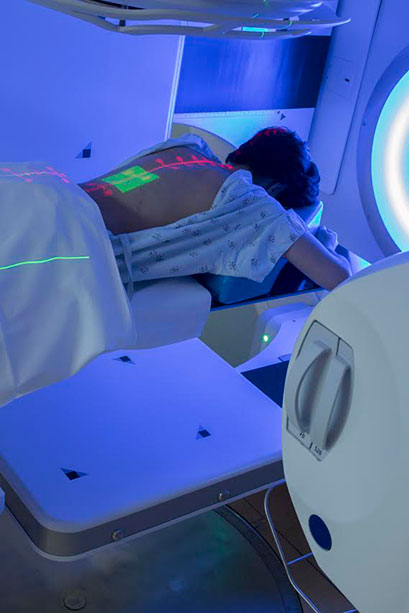Three-Dimensional Radiation Treatment (3D-CRT)
Three-dimensional conformal radiation therapy, or 3D-CRT, involves creating 3-D computer images and delivering highly focused radiation to tumors while sparing nearby healthy tissue.
What Is Three-Dimensional Radiation Treatment?
3D-CRT is a type of external beam radiation therapy, which is the most common radiation treatment used for mesothelioma. New methods of providing radiotherapy make irradiating the affected area more precise. Shaping the radiation beam to the 3D shape of the tumor reduces the risk of side effects.
A radiation oncologist creates customized beams with devices such as:
- Multileaf Collimator: This device attaches to the head of the radiation machine. It has rows of platelets that are separate from each other, known as leaves. The leaves can be manipulated to create the initial shape and size of the portal the beams are emitted through.
- Custom-Fabricated, Field-Shaping Blocks: These are made of a material such as lead that stops radiation. They’re placed around the portal to further conform the radiation beams to the shape of the tumor.
A treatment session of 3D-CRT typically lasts 15 to 30 minutes, although the first appointment may be longer. Intensity-modulated radiation therapy is an advanced form of 3D-CRT. It’s even safer and more effective for pleural mesothelioma.
IMRT uses the precise 3D targeting of 3D-CRT but also changes the speed and strength of the radiation beams in certain areas. In 2021, mesothelioma researchers published their findings on 3D-CRT in the Journal of Thoracic Disease. The authors said it can help deliver precise radiation dosages. In palliative care, 3D-CRT can help reduce symptom severity.
How Does 3D-CRT Benefit Mesothelioma Patients?
3D-CRT radiation can improve the control of tumor spreading and prevent recurrence in mesothelioma patients. Radiation’s ideal role in multimodality treatment for mesothelioma is still under evaluation.

Two-dimensional images gathered from a patient’s CT scans, MRIs and PET scans are fed into a dome-shaped projector that rotates. This dome, which is plugged into a computer, projects the images into three dimensions.
These are not pictorial images like the ones seen on other tests. These 3D holograms are light images showing characteristics such as the tumor’s size, shape and location and the organs surrounding it.
Research shows that after extrapleural pneumonectomy (surgery to remove a lung), it’s possible to use 3D-CRT to deliver high doses of radiation without serious risk. However, the radiation oncologist must be careful about exposing the remaining lung to radiation.
What Are the Side Effects of 3D-CRT?
Side effects of 3D-CRT are generally related to the area of the body being treated. These side effects usually aren’t serious and go away within 4 to 6 weeks after treatment ends. Medication or changes to your diet can help control potential side effects. Some patients treated with 3D-CRT experience no side effects.
Three-dimensional conformal radiotherapy is a complex process that requires an experienced radiation oncologist. Especially when treating pleural mesothelioma patients. A part of the ongoing investigation of 3D-CRT is experimentation with how to deliver high doses of radiation to the chest without damaging normal tissue — especially within the lung.
Side effects of 3D-CRT
- Radiation Pneumonitis: An inflammation of the lungs that typically starts within 2 to 3 months of the start of the radiotherapy. Its symptoms can include a dry cough, shortness of breath and low-grade fever. In rare cases, it can lead to permanent scarring of the lungs.
- Esophagitis: Occurs when the esophagus (the food tube that runs from the throat to the stomach) becomes inflamed. This condition typically starts about 2 weeks after the beginning of treatment and usually disappears about 2 to 3 weeks after treatment is completed.
- Fatigue: A feeling of weakness or exhaustion that doesn’t go away after resting. Fatigue is typically most severe 2 to 4 hours after a radiation session. It may also peak between the third and fifth week of treatment.
Consult with your oncology team to determine if 3D-CRT is the best form of radiation for you. Every mesothelioma case is unique.
A mesothelioma doctor will create the best treatment plan for you based on certain factors. These include the location and size of tumors, their stage and your overall health.

Connect with trusted specialists who truly care about your health. Get fast, stress-free appointment help.
Find a Doctor NowCommon Questions About 3D-CRT
- What is the difference between 3D-CRT and IMRT?
-
Intensity-modulated radiation therapy, or IMRT, modulates the intensity of radiation treatment. By adjusting the intensity, IMRT can target tumors with higher doses of radiation while minimizing damage to healthy tissues.
Oncologists can combine 3DCRT with IMRT to control mesothelioma growth, lower the risk of recurrence and minimize side effects.
- Can 3D-CRT effectively treat mesothelioma?
-
Current research concludes that both IMRT and 3DCRT can benefit mesothelioma patients. Some studies have reported benefits of 3D-CRT to patients after surgery, as well. Clinical trials are continuing to test methods that make 3D-CRT safe and effective for treating mesothelioma patients at various stages.
- What should I expect when undergoing 3D-CRT?
-
Patients undergoing 3D-CRT spend more time in the scanner than traditional radiation therapy. These scans can take up to a couple of hours. After scans are complete, your medical team will create an individualized 3D-CRT treatment plan which can take up to a week or more.
On the next visit, patients will spend about half an hour lying down while receiving the radiation in a special treatment room. The treatment is painless and can be performed several times over the course of a few days.



